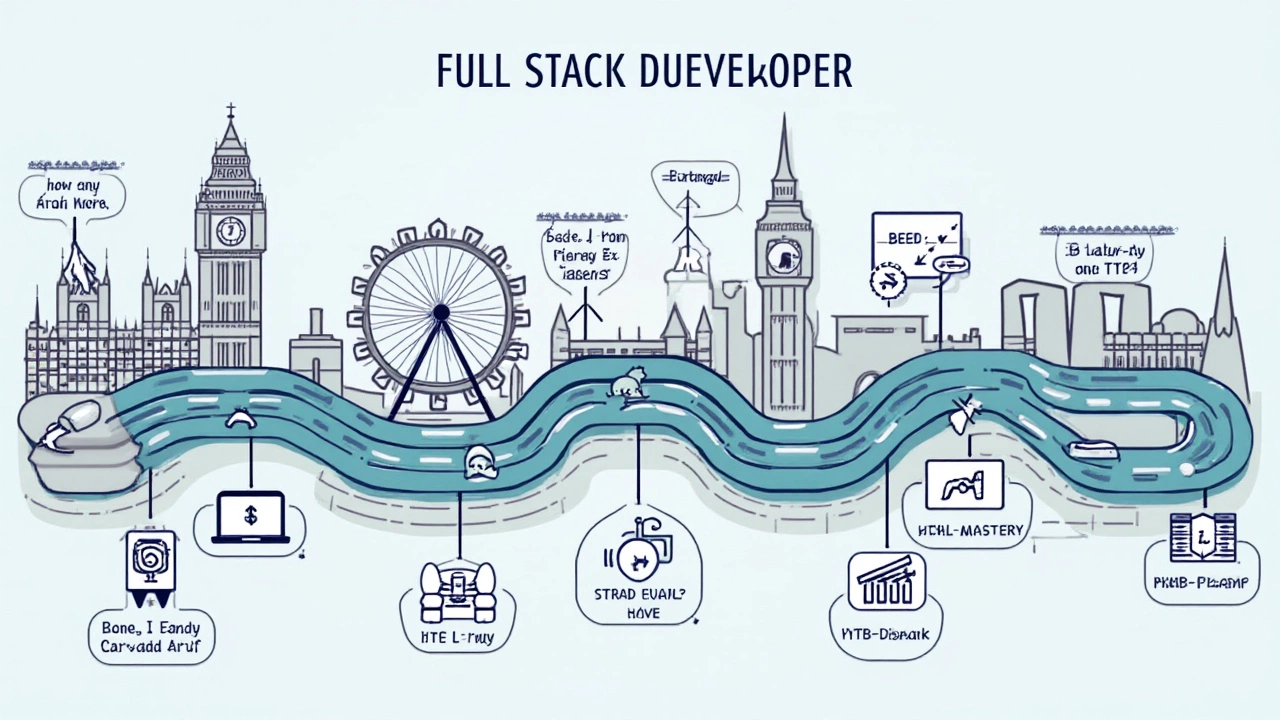Diving into the world of full stack development is an exciting venture, blending creativity with logic, and design with architecture. In today's digital age, the demand for skilled developers is ever-growing, making it an attractive career path for many.
With a well-defined plan and a commitment to continual learning, it's possible to become proficient in full stack development in just two years. This journey requires mastering both client-side and server-side technologies, leading to a versatile skill set that is highly valued in the tech industry.
Join me as we explore the road to becoming a full stack developer, offering insights into essential skills, strategic learning approaches, and the importance of practical experience.
- Understanding the Full Stack
- Crafting a Learning Path
- Essential Skills and Technologies
- Practical Experience and Projects
- Staying Updated with Industry Trends
Understanding the Full Stack
Diving into the world of full stack development is akin to learning the inner workings of both the gears of a finely-tuned watch and the intricate details of the face that tells time. It encapsulates the complete range of technologies that power web applications, wearing two hats: one for front-end development dealing with the visible portion to users, and the other for back-end development, managing the server, databases, and application logic. This dual mastery makes full stack developers highly versatile, capable of maneuvering between user interfaces and system software with ease.
The front end, often referred to as the 'client side,' is where all the magic begins in engaging a user. It's the layout of the website, the colors, the fonts, and the overall aesthetic vibe a visitor interacts with. Technologies like HTML, CSS, and JavaScript form the trio of tools that developers use to breathe life into the static pictures and designs we see online. These languages set the foundational framework for more advanced libraries and frameworks like React, Angular, and Vue.js, which carve out dynamic and responsive web experiences.
On the flip side, the back end — often unseen but deeply influential — is responsible for how users interact with the application beyond what they see on their screens. This part of full stack development involves servers that process user requests, databases that store information, and applications that respond with the right data. Imagine a restaurant where the user interface is the menu and décor, the back end is the kitchen, ensuring every dish is prepared to perfection. Languages like Python, Ruby, Java, and PHP are popular choices, providing essential services like authentication, data processing, and server management.
According to a 2023 Stack Overflow Developer Survey, over 46% of web developers identify as full stack. Despite the complexity, their role remains vital due to their ability to oversee entire application development processes and bridge the gap between front and back-end teams. Thomas Friedman in his celebrated book "The World is Flat" touched on this versatility:
"The most important attribute you can have is the ability to learn how to learn."This adaptability is quintessential to a full stack developer, where learning never stops, and the technology continuously evolves.
Awareness of the leading databases like MySQL, MongoDB, or PostgreSQL is crucial since they are the warehouses of the web. Complementary to these are web servers like Apache, Nginx, or Microsoft’s IIS, bearing the weight of serving millions of requests reliably and efficiently. Coupled with these are understanding deployment platforms and version control systems. Such expertise not only ensures the smooth functioning of web applications but also empowers developers to troubleshoot and optimize performance across the board.
Becoming adept at full stack development means embarking on a continuous journey of learning and improvement. It entails keeping pace with the latest tech trends, tools, and best practices. The diversity of skills while daunting opens doors to endless opportunities, be it in startups where wearing multiple hats is the norm or in large corporations valuing a broad overview of the project landscape. The essence lies in persistence, curiosity, and the thrill of building something new from code across different programming realms.
Crafting a Learning Path
The journey to becoming a full stack developer in two years is undoubtedly a thrilling endeavor. It is one that requires careful planning and discipline. Crafting a cohesive learning path is vital to ensure that you are building on a solid foundation. Start by identifying the essential technologies that make up the web development world. These typically include HTML, CSS, and JavaScript for front-end development, and at least one server-side language such as Python, Java, or Node.js for back-end development. The right combination of these skills will allow you to handle both ends of the stack proficiently.
As you establish your learning path, consider your educational preferences. Some individuals thrive in classroom settings, taking advantage of coding bootcamps or university courses to deliver structured content and peer interaction. Others might prefer the flexibility of self-study, using online resources such as freeCodeCamp, Codecademy, or Coursera, which have become popular hubs for learning programming online. These platforms offer tutorials, hands-on projects, and community forums, which can be instrumental in consolidating your knowledge and keeping you motivated. An insightful quote from John Resig, the creator of jQuery, suggests,
"Learning programming is the distillation of solving problems and building something you find valuable."Think about joining development communities like Stack Overflow or GitHub to network and collaborate with other learners and professionals.
It's important, however, not to simply consume information but apply it through projects. Begin with basic applications and gradually increase complexity. This project-based approach ensures you're not only practicing your coding skills but also gaining hands-on experience that simulates real-world problems. For example, building a simple to-do app can introduce you to DOM manipulation with JavaScript. As you progress, you can tackle larger projects such as developing e-commerce sites or creating RESTful APIs. These experiences will be invaluable as they allow you to connect theory with practice while also demonstrating your ability to prospective employers.
Monitoring your progress is another integral aspect of your learning path. Set milestones to assess where you stand against your programming career goals. Every few months, take time to revisit your previous projects or try solving new problems to test your skill retention and growth. This assessment not only provides a sense of accomplishment but also highlights areas where you might require further study or practice. Remember, the landscape of technology is always changing, and what is relevant today may evolve tomorrow, making adaptability a crucial trait for any developer. Explore current technologies, frameworks, and tools such as React, Angular, or Vue.js in the front-end world, and experiments with NoSQL databases like MongoDB, or serverless architecture and cloud platforms as they become increasingly integrated into the profession.

Essential Skills and Technologies
Embarking on the journey to become a full stack developer is akin to navigating through a multifaceted landscape of skills and technologies. The role requires a deft balance between aesthetic sensibility and technical precision, creating a seamless user experience from both the front and back ends.
The journey typically starts with mastering the front-end technologies, which are the very first things the user interacts with. HTML, CSS, and JavaScript lay the groundwork, being the core trio essential for crafting web interfaces. Proficiency in HTML provides the structure, while CSS introduces style and aesthetics, transforming raw data into visually engaging experiences. JavaScript is the engine that brings these experiences to life, through interactivity and dynamic content. Dig deeper, and you'll find frameworks like React, Angular, or Vue.js are indispensable for building complex user interfaces efficiently.
Transitioning to the back-end, a full stack developer must gain a solid grip on server-side technologies and database management. Here, languages such as Node.js, Python, or Ruby come into play, each offering unique strengths in handling server logic and interactions. Understanding databases is equally crucial, where knowledge of SQL and NoSQL databases, like PostgreSQL and MongoDB, comes into focus. An understanding of RESTful services and APIs is also paramount, as it bridges the gap between front-end and back-end seamlessly.
In the words of Armin Ronacher, the creator of the popular Python flask framework, "The onus is upon the developer not just to understand singular technologies, but to weave them together into cohesive applications."
"The onus is upon the developer not just to understand singular technologies, but to weave them together into cohesive applications." — Armin Ronacher, Flask Creator
Beyond these foundational aspects, version control with Git is a non-negotiable skill in any developer's toolkit. As collaborative development becomes more prevalent, understanding how to manage changes in code efficiently through platforms like GitHub or GitLab becomes vital. This forms the backbone of collaborative projects, ensuring version consistency and facilitating smooth teamwork across distances.
No discussion of full stack development is complete without acknowledging the importance of devops essentials. Skills in containerization and cloud services, through tools like Docker or platforms like AWS, prepare developers to deploy and manage applications at scale. Familiarity with Continuous Integration and Continuous Deployment (CI/CD) processes ensures that a developer can streamline updates and maintain the integrity of live applications. As the industry evolves, staying abreast of these practices positions a full stack developer at the forefront of technological advancement.
Practical Experience and Projects
Embarking on the journey to become a full stack developer is much like setting sail on a vast ocean. While theoretical knowledge forms the foundation, practical experience steers you towards solid competence. For aspiring developers, engaging in real-world projects is not only about applying what you've learned but also about gaining confidence in problem-solving and adapting to new challenges. Working on diverse projects allows developers to encounter a spectrum of problems, fostering innovative thinking and adaptability. It's important to immerse yourself in environments that simulate actual industry challenges, which offer insights into collaborative work, deadlines, and evolving client needs. By diving into actual projects, one can decode the rhythms and complexities of full-stack development effectively.
Understanding various frameworks and coding languages is crucial, but implementing them in practical scenarios truly cements your skills. Let's say you're familiar with languages like JavaScript or Python; seeing their interplay with databases or front-end frameworks in action makes a huge difference in comprehension. Real projects enable you to experiment with these technologies, encouraging a nimble mindset. Engaging with open-source projects and contributing to platforms like GitHub is an excellent start. This not only sharpens your technical skills but also exposes you to the process of code review, a critical industry skill.
"Practice does not make perfect. Only perfect practice makes perfect." - Vince LombardiBear this adage in mind, and focus on deliberate, quality practice in your projects, rather than mere repetition of techniques.
Another rewarding aspect of hands-on projects is the opportunity to develop a portfolio, which acts as a visual and experiential showcase of your capabilities. A well-curated portfolio communicates your expertise better than any resume. Highlight versatile project types, such as e-commerce platforms, interactive web applications, or API integrations, demonstrating your adaptability across different domains of web development. Employers and clients are quick to recognize practical experience and successful outcomes more than theoretical prowess. Moreover, these projects provide a testbed for continuous learning. For instance, encountering a new problem may lead you to discover more efficient algorithms or new libraries and tools, which can enhance productivity and code quality.
The value of mentorship and collaborative projects cannot be overstated. Joining coding bootcamps or online communities where you can receive guidance from seasoned developers can accelerate your learning curve. Working with others introduces you to different coding styles and methodologies, broadening your understanding of web development practices. These collaborations often lead to knowledge sharing sessions, hackathons, or peer reviews, which are invaluable experiences in your growth as a developer. Imagine the collective brainpower when a group tackles complex coding challenges together. This synergy not only fosters creativity but also resilience in facing technical hurdles.
Finally, keep an eye on emerging trends and technologies within the industry. The digital world is in constant flux, with new tools and updates emerging regularly. Embrace platforms that offer continuous education to keep your skills sharp and relevant. Whether it's mastering a new framework or understanding the nuances of cloud computing, staying abreast of industry trends is crucial. This ensures that the path you've chosen is not only sustainable but also aligned with the industry demands. A proactive approach in seeking practical experiences will undoubtedly pave your way to become a competent and successful full stack developer within two years.

Staying Updated with Industry Trends
In the ever-evolving world of technology, staying ahead involves keeping up with the latest trends in web development. This might seem daunting, given the rapid pace of innovation, but it's essential for any aspiring full stack developer who wants to excel. A commitment to lifelong learning will ensure your skills remain relevant. Embrace the shifting landscape by subscribing to industry-leading blogs and podcasts. These resources offer insights from experts who share cutting-edge developments and offer solutions to common challenges faced by developers today. Engage with platforms like Stack Overflow and GitHub, where the community discusses the latest tools, frameworks, and game-changing innovations.
Moreover, attending conferences and webinars can provide a broader perspective on what's shaping the future of web development. These events often feature talks from industry leaders, showcasing new technologies and practices. Participating in such gatherings can ignite fresh ideas and foster valuable networking opportunities with fellow developers. Consider aligning your learning paths with current market demands, focusing on what companies are looking for in a full stack developer. Enhance your knowledge of popular programming languages like JavaScript, Python, and Ruby, which continue to be at the forefront of development trends.
"The secret of getting ahead is getting started," advised Mark Twain, reminding us of the importance of action over endless preparation in a fast-paced world.
To effectively track emerging trends, follow tech influencers and developers who actively share their views and experiences on social media. These professionals often point to new directions in the tech landscape before they become widely discussed. Additionally, make use of newsletters from trusted sources like TechCrunch and Wired, which compile essential updates in a digestible format. It's vital also to keep an analytical mindset while exploring trends to discern between fleeting fads and genuine shifts that could shape the future of web development.
Finally, dedicating time to experimenting with new frameworks and tools will bridge the gap between theory and practice. Challenge yourself to apply these innovations to personal projects or contribute to open-source initiatives. This proactive approach not only bolsters your resume but imbues you with a deeper understanding of current trends, enhancing your profile as a versatile and informed full stack developer.
